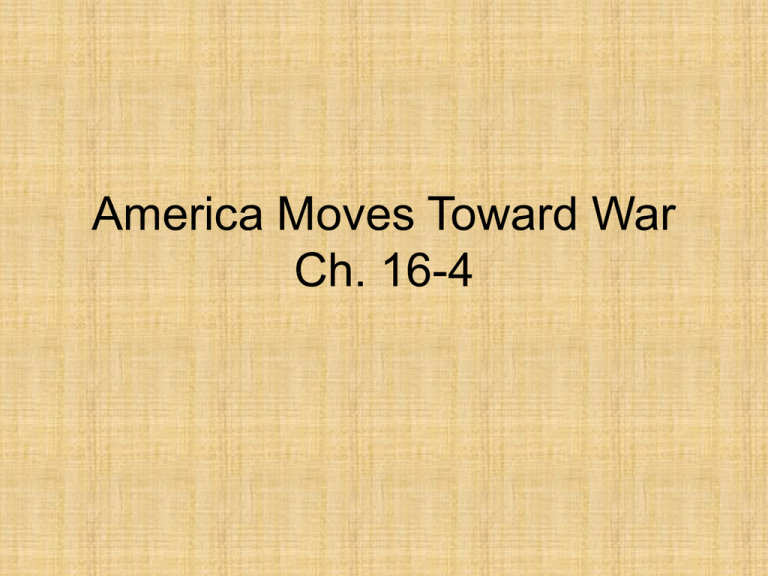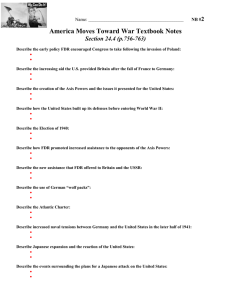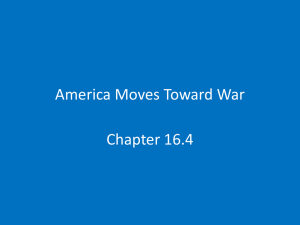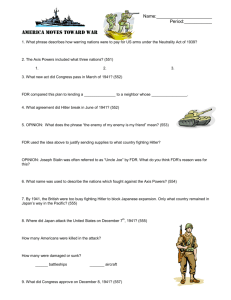America Moves Toward War Ch. 16-4
advertisement

America Moves Toward War Ch. 16-4 Cautiously Moving • Roosevelt wanted to help France and Great Britain fight against Hitler in order to keep the U.S. out of war. • Therefore, FDR passed a “cash-and-carry” provision that allowed warring nations to buy arms as long as they paid cash and transported them on their own ships. • The U.S. had sent 500,000 rifles, 80,000 machine guns, and 50 destroyers. The AXIS Powers • Germany, Italy, and Japan signed a mutual defense treaty and became known as the Axis Powers. • This meant that if the U.S. declared War on any of the Axis Powers, it would have a two-ocean war, with fighting in the Pacific and Atlantic (Japan and Europe). • During this time, FDR ran for a third term and won. He broke George Washington’s tradition of a two-term presidency. FDR’s Plan • FDR warned that if Britain fell to Germany then the AXIS Powers would conquer the world. • Lend Lease Plan- the president would lend or lease arms and other supplies to any country whose defense was vital to the U.S. Supporting Stalin • Hitler broke his agreement with Stalin and invaded the Soviet Union. Therefore, FDR began sending lend-lease supplies to the Soviet Union. • “If Hitler invaded Hell” the British would be prepared to work with the devil himself. (Winston Churchill) German Wolf Packs • To prevent delivery f lend-lease shipments, Hitler deployed hundreds of submarines to attack ships. • FDR allowed the navy permission to attack the U-boats in self defense. Atlantic Charter • The Atlantic Charter became the basis for “A Declaration of the United Nations.” • The term “United Nations” express the common purpose of the Allies or those nations that fought the Axis Powers. Hideki Tojo • Hideki Tojo wanted to unite Asia by taking the French, Dutch, and British colonies in Asia. • The British were too busy fighting Hitler to stop Japan’s expansion. • Japan took over Indochina (Vietnam, Laos, Cambodia), and the U.S. protested by cutting off trade with Japan. • They stopped trading oil to fuel its war. Peace Talks with Japan • Tojo promised Japan’s emperor, Hirochito, that he would keep the peace with the Americans. • On Nov. 5, 1941, Tojo ordered the Japanese navy to prepare for an attack on the U.S. • The U.S. broke Japan’s secret communication codes and learned that Japan was preparing for a strike, but did not know when or where. • The U.S. and Japan’s peace talks went on for a month and on Dec 6, 1941, FDR received a decoded message that said that Japan would reject all American peace proposals. December 7, 1941 • For 1 ½ hours, 180 warplanes attacked Pearl Harbor, Hawaii. • Japan killed 2,403 Americans and wounded 1,178. • The next day FDR addressed Congress with his famous infamy speech: “Yesterday December 7, 1941, a date which will live in infamy…” • Congress then approved FDR’s declaration of war against Japan. • Three days later, Germany and Italy declared war on the U.S.






